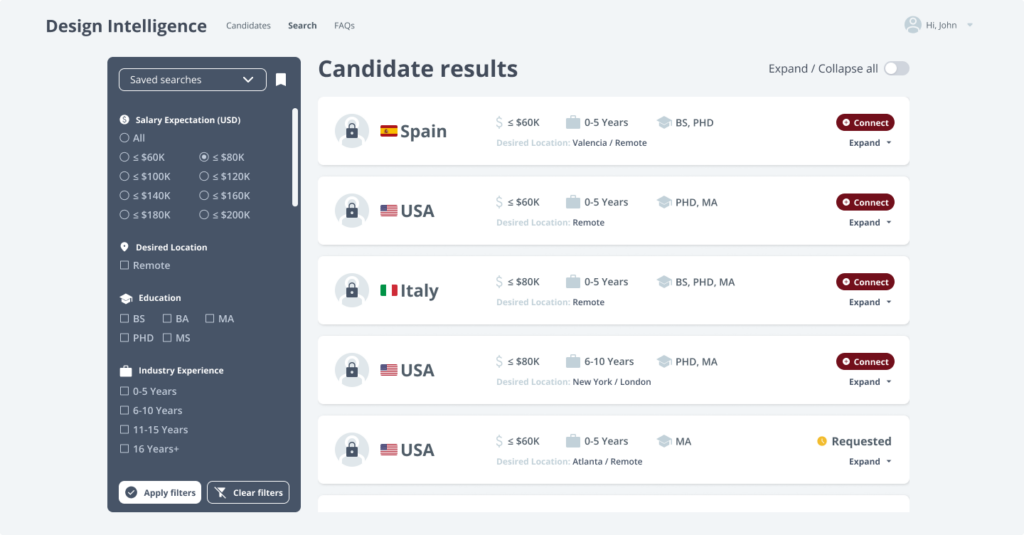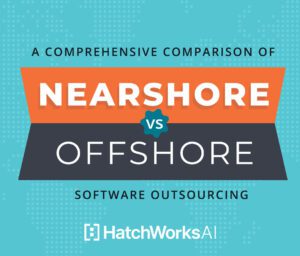Long distance relationships are hard. They’re made harder still when operating from different time zones.
It’s the same when a company outsources software development. Drastically different time zones can complicate processes and cause frustration between your team and the developers.
The same or similar time zones, however, allows you time to communicate, collaborate, and align on high-impact projects without delay.
Which is why companies are turning to a time zone friendly outsourcing model.
But what exactly is it? How does it work? And what are the pros, cons, and best practices you need to consider before you move forward?

In this article, we cover all that and more with a special focus on Nearshore Software Development—which is what we do best.
What is Time Zone Friendly Outsourcing?
Time zone friendly outsourcing is when you outsource work to a person or company that has a similar geographical location to you, and as a result, similar working hours.
For example, if a US company outsources software development to South America.
In this example, the company can reduce costs while problem solving in real-time with developers, getting timely updates, and accelerating toward desired project outcomes.
Compare this to outsourcing to India or the Philippines. Sure, offshore tech teams are inexpensive compared to US based alternatives but with only a few working hours to align, you’ll run into complications in communication and delays in project progress. One misunderstanding can result in hours of wasted work—and as a consequence, wasted money.
Time zone friendly outsourced work is the perfect blend of cost-effective labor and real-time collaboration.
If you want to learn more about the differences between outsourcing models, read our comprehensive comparison of Nearshore vs. Offshore software outsourcing.
Why Do Time Zones Matter When Outsourcing?
Imagine you send a brief over to an offshore development team with a time zone difference.
They’re based in India and they get started on the project while you’re asleep—only they don’t fully understand the brief. There’s confusion over the web and mobile app specs.
The project has a quick turnaround time so they make their assumptions and move forward.
It will go one of three ways:
- They wait to get started until you can clarify, delaying the project from the offset.
- The next day you find that hours of work have been wasted working toward the wrong thing.
- The problem only surfaces toward the end of the project when you’re about to launch.
That’s why time zones matter.
Being in the same or neighboring time zones facilitates instant and regular communication that can help you progress faster and stay in alignment.
The Pros and Cons of Time Zone Friendly Outsourcing
Time zone friendly outsourcing, like any business strategy, comes with advantages and challenges.
Knowing what they are can help you decide if it’s best placed to help you reduce costs and meet your business goals.
Pros and Cons of Time Zone Friendly Outsourcing
|
Pros
|
Cons
|
|---|---|
|
Same time zone improves communication
|
A smaller talent pool than when looking globally
|
|
More cost efficient than hiring or expensive local agencies
|
Cultural differences may cause friction
|
|
Increased productivity when you can collab in real-time
|
May not be the cheapest labour available
|
|
Reduce project delays by problem solving the same day the problem arises
|
|
|
Schedule meetings within normal working hours
|
Pros of Outsourcing to the Same Time Zone
Improved Communication:
Being in the same or neighboring time zones means teams can communicate in real-time. This reduces the chances of misunderstandings and ensures everyone is on the same page.Increased Productivity:
With aligned working hours, there’s a continuous flow of work. Teams can collaborate, address issues, and make decisions promptly, keeping the project momentum going.Flexible Scheduling:
Online meetings, brainstorming sessions, and reviews can be scheduled in your business hours, ensuring timely feedback and alignment.Cost-Efficiency:
It might not be the cheapest outsourcing option, but it beats having to hire an in-house team. Plus the balance of cost and productivity often results in better value for money than using an offshore team.Reduced Project Delays:
Immediate problem resolution means fewer hiccups and smoother project progression.Cons of Outsourcing to the Same Time Zone
Limited Talent Pool:
By focusing on specific time zones (such as in Latin American countries), you might miss out on global talent available in other regions (Europe and Asia).Potential Higher Costs:
Depending on the region, the costs might be higher than some offshore outsourcing options. The convenience of working within the same time zone usually offsets any cost differences. Plus, it’s still a cost efficient option.Cultural Differences:
Even within similar time zones, there can be cultural differences that might require adjustments in collaboration styles.Best Practices for Time Zone Friendly Outsourcing
With 60% of businesses planning to outsource development work, it’s important to follow a set of best practices that ensures their time and resources aren’t wasted on insufficient results.
Using Nearshore software developers (time zone compatible outsourcing) comes with its own set of best practices. Follow them and you’ll feel more confident in the capabilities of your Nearshore team.
Schedule regular updates: Keeping both teams informed is crucial. Schedule daily or weekly check-ins to discuss progress, address challenges, and align on next steps.
Set up communication channels: Establish dedicated channels for different types of communication. Whether it’s a chat for quick queries, a video call for brainstorming, or an email for formal updates, having clear channels reduces confusion.
Work with flexibility: While the essence of this model is time zone alignment, a little flexibility can go a long way. If there’s a slight difference in working hours, consider adjusting your team’s schedule occasionally to ensure overlap.
Document everything: Ensure all project details, from requirements to feedback, are documented. This aids in project coordination and ensures that nothing gets lost in translation.
Onboard and train your new team: Equip your outsourced team with all the necessary training and resources they need. This ensures they’re aligned with your company’s objectives and processes.
Tools to Facilitate Seamless Collaboration with Your Nearshore Developers
Geographical and cultural barriers are easily overcome when you have the right tools in your tech stack.
Here are our favorite collaboration tools when working with a remote team, whether offshore, Nearshore, or in-house.
- Video Conferencing Platforms: Whether it’s a quick catch-up or a detailed project review, tools like Google Meets, MS Teams, and Zoom offer reliable video conferencing solutions that make virtual meetings feel almost as good as face-to-face interactions.
- Jira: A go-to tool for many software developers, Jira offers robust project management and tracking capabilities. It’s ideal for setting tasks, monitoring progress, and ensuring everyone is aligned on project milestones.
- Atlassian Confluence: This platform complements Jira by providing a space for teams to create, share, and collaborate on documents. Whether it’s project documentation, meeting notes, or brainstorming ideas, Confluence keeps everything organized.
- Miro: An online collaborative whiteboard, Miro is perfect for brainstorming sessions, design thinking, and mapping out workflows. It brings the interactive experience of a physical whiteboard to the virtual space.
- Slack: For real-time communication, Slack stands out. It allows teams to have quick chats, share files, and even integrate with other tools to ensure everyone stays in the loop.
- Trello: For project coordination, Trello offers a visual board where tasks can be tracked, assigned, and updated.
Time Zone Friendly Outsourcing in Practice: Case Study
 DesignIntelligence, a global leader in the architecture, engineering, construction, and design industries wanted to create a software solution that streamlined the hiring process for architecture firms.
DesignIntelligence, a global leader in the architecture, engineering, construction, and design industries wanted to create a software solution that streamlined the hiring process for architecture firms.
They turned to HatchWorks to make this a reality and relied on software developers based in Latin America to reduce costs without sacrificing quality.
The process began with an in-depth solution workshop. HatchWorks and DesignIntelligence’s core stakeholders aligned on vision, goals, and user needs.
This collaborative approach, made smoother without significant time zone differences, allowed for swift decision-making and ideation.
Ultimately, it was the synergy between the two teams that resulted in a robust MVP of the software delivered in a tight 3-month timeframe.
Read the full case study: DesignIntelligence – HatchWorks
How to Choose the Right Outsourcing Partner
Working in the same time zone is just one piece of the puzzle. You also need to ensure the outsourcing team you choose is efficient and effective at software development.
They need to integrate seamlessly with your company’s processes, understand your needs, and deliver a project that meets (if not exceeds) expectations.
So when considering Nearshore outsourcing companies, it’s important that they:
- have the technical expertise to complete the job and are skilled in emerging technologies (including generative AI)
- prove that expertise with client testimonials and case studies
- have headquarters in the US for local accountability and service
- have in-country management of their Latin America developer team (thus managing the developer team for you)
- see high employee retention (leaving little chance team changes will disrupt your project)
- Real-time collaboration within your working hours
- are a cost-effective alternative to US based outsourcing
- deliver outcome based projects and project based work in addition to staff augmentation
- demonstrate clear, proactive communication throughout the sales process
- follow an Agile approach
It’s important you don’t rush your decision. Take the time to research potential partners, conduct interviews, and even consider trial projects to gauge their capabilities.
As you delve into your research, you might find our recent analysis on top-ranking nearshore software companies to be a valuable resource.
Additional Resources
If you’re interested in time zone friendly outsourcing you may find these articles interesting.
We’re ready to support your project!
Instantly access the power of AI with our AI Engineering Teams.




